The enforced emigration of Ireland’s life blood over centuries, which came to a head during and after the Great Famine (1845-1851) is one of the reasons for the huge Irish worldwide diaspora and the fairly ludicrous situation that by far the greater part of people of Irish descent do not and never have lived on the island.
Every part of
Numbers actually confined within the Workhouse at any one time may have represented less than one tenth of those greatly suffering from disease, starvation and extreme malnutrition yet there were protracted periods when substantially more than a thousand souls sought refuge in Newry’s Workhouse (of Newry’s population of the time of about 13000 people). It follows that perhaps half of all Newry’s residents were adversely affected in the Famine years and substantial numbers emigrated then or in the decades to follow – indeed the trend continued for more than a century.
It beggars belief therefore, that Tony Canavan in his otherwise excellent general history of Newry ‘
‘Ships carried thousands from Newry and Warrenpoint, sometimes directly to
Perhaps Canavan was following too closely the previous Newry general history – that of John F Small published in 1876, ‘Historical Sketch of Newry’. That author writing in the immediate aftermath of the Famine and in the very period when emigration rates were at their highest, managed to omit any reference to either phenomenon. Yet his work is replete with self-edifying profiles of such ‘heroes’ of Newry’s past as Isaac Corry, the man who sold Ireland for his own niggardly political ambitions which in the end and in any case came to naught.
Having said all that, I will in later articles attempt a more generous appraisal of Small’s marathon work. It is actually as long as Canavan’s book though nowhere nearly as detailed or as good and useful to modern day scholars. Yet it is a seminal work of interest to us all.
